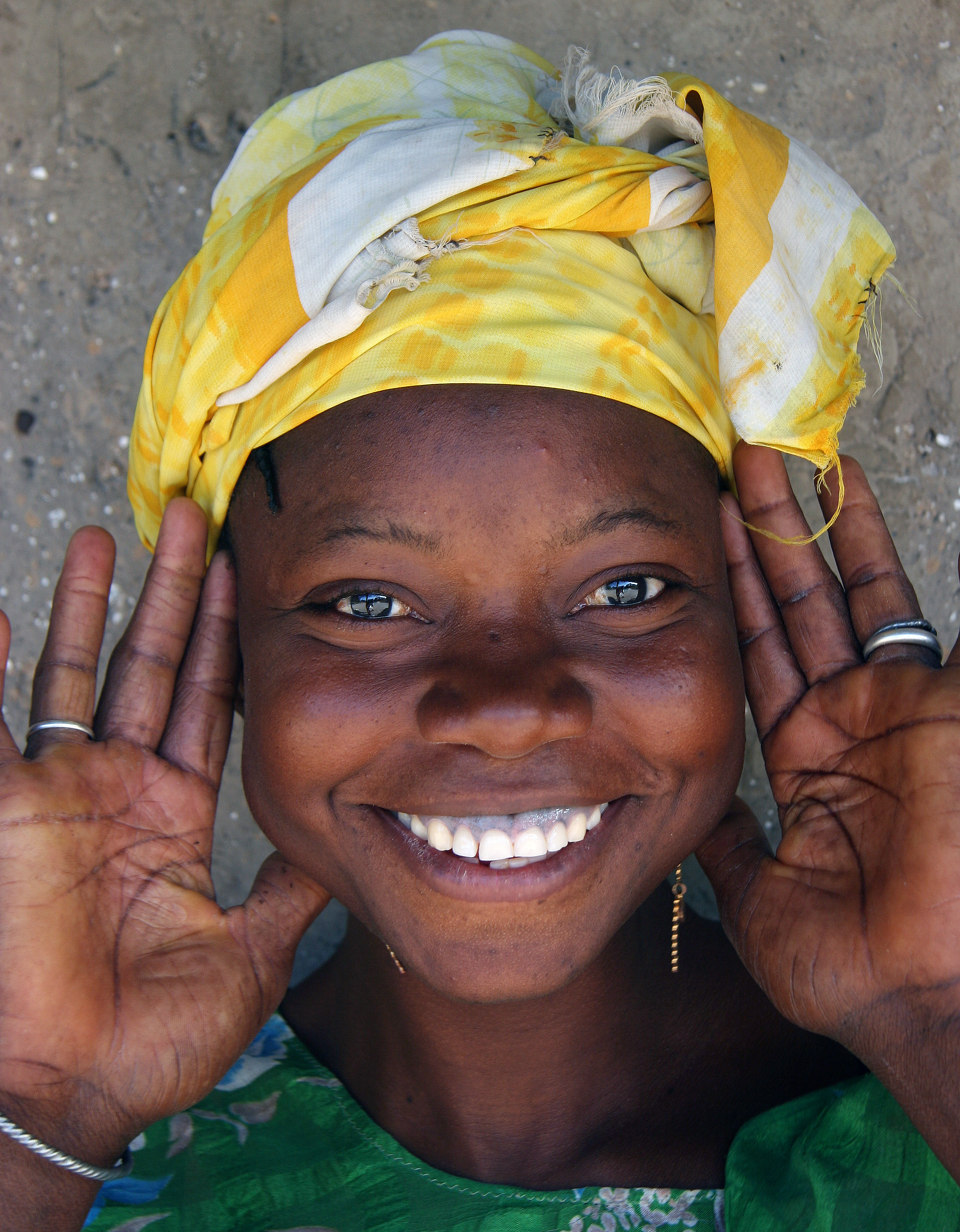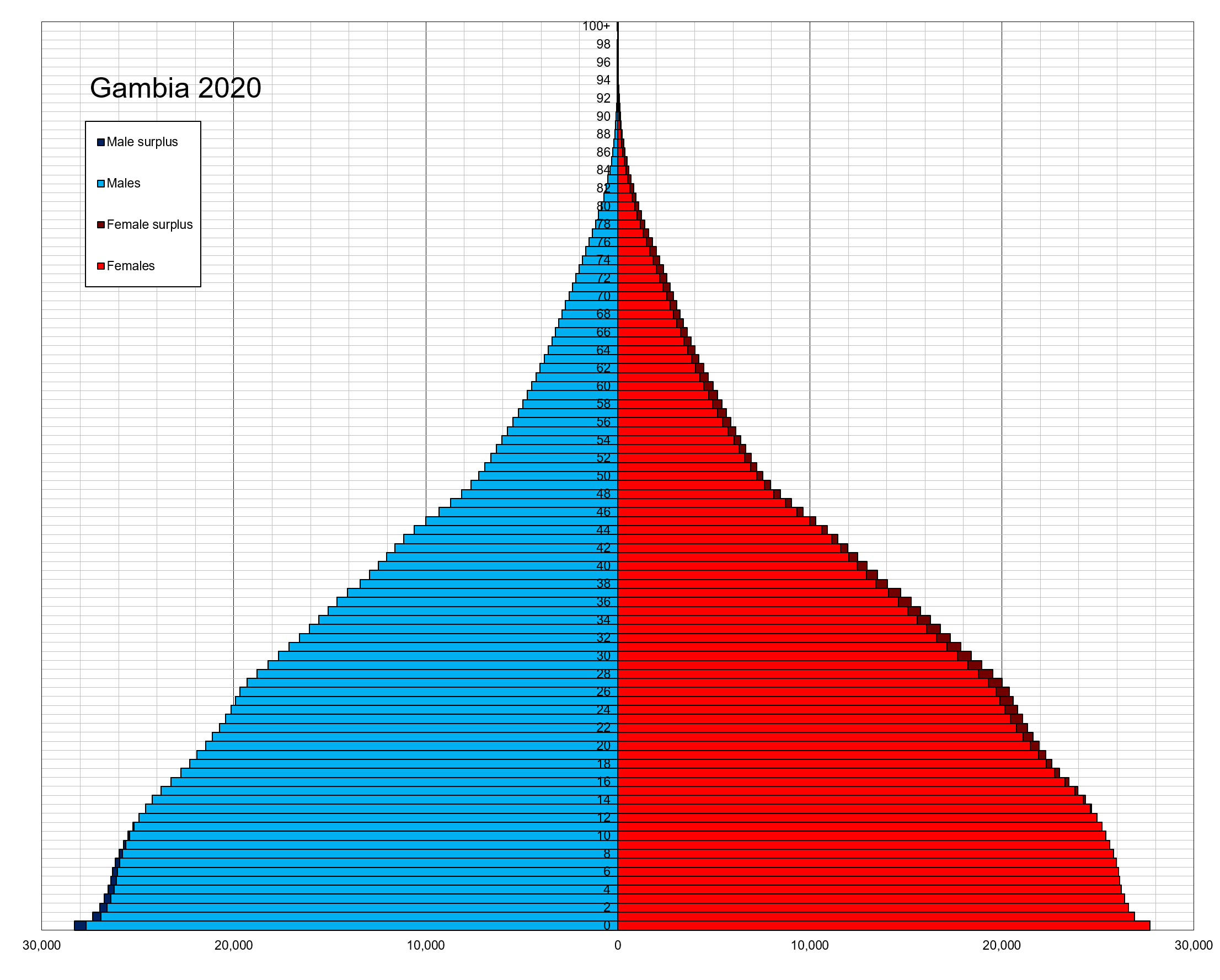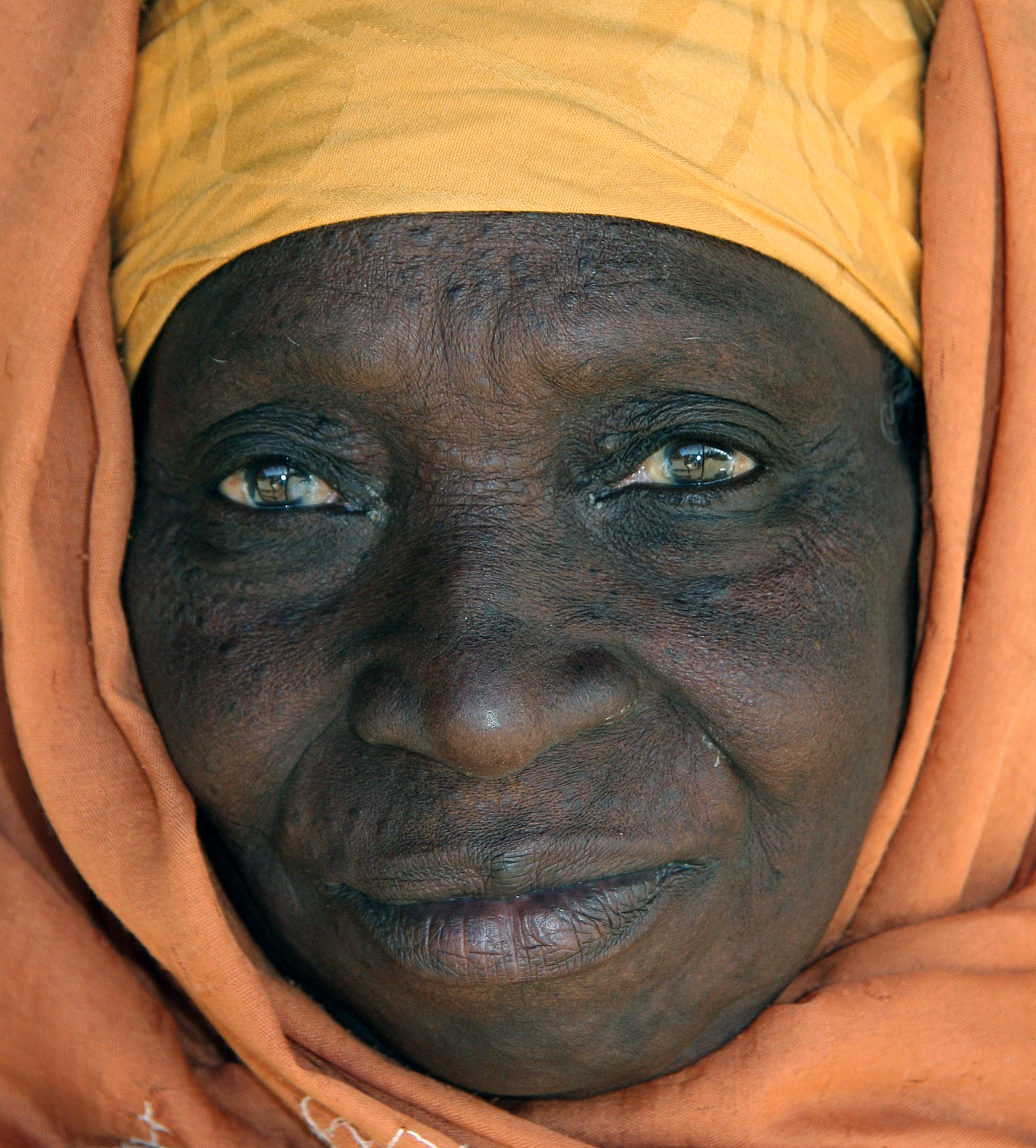Demographics of the Gambia on:
[Wikipedia]
[Google]
[Amazon]
The demographic characteristics of the population of The Gambia are known through national
 Sources:
Fertility Rate TFR (Wanted Fertility Rate) and CBR (Crude Birth Rate):
Structure of the population (
Sources:
Fertility Rate TFR (Wanted Fertility Rate) and CBR (Crude Birth Rate):
Structure of the population (
 :''0-14 years:'' 35.15% (male 391,993/female 388,816)
:''15-24 years:'' 20.12% (male 221,519/female 225,414)
:''25-54 years:'' 36.39% (male 396,261/female 412,122)
:''55-64 years:'' 4.53% (male 48,032/female 52,538)
:''65 years and over:'' 3.81% (male 38,805/female 45,801) (2021 est.)
:''0-14 years:'' 36.97% (male 388,615 /female 385,172)
:''15-24 years:'' 20.31% (male 210,217 /female 214,807)
:''25-54 years:'' 34.9% (male 357,934 /female 372,428)
:''55-64 years:'' 4.26% (male 42,655 /female 46,591)
:''65 years and over:'' 3.55% (male 34,328 /female 39,984) (2018 est.)
:
:''0-14 years:'' 35.15% (male 391,993/female 388,816)
:''15-24 years:'' 20.12% (male 221,519/female 225,414)
:''25-54 years:'' 36.39% (male 396,261/female 412,122)
:''55-64 years:'' 4.53% (male 48,032/female 52,538)
:''65 years and over:'' 3.81% (male 38,805/female 45,801) (2021 est.)
:''0-14 years:'' 36.97% (male 388,615 /female 385,172)
:''15-24 years:'' 20.31% (male 210,217 /female 214,807)
:''25-54 years:'' 34.9% (male 357,934 /female 372,428)
:''55-64 years:'' 4.26% (male 42,655 /female 46,591)
:''65 years and over:'' 3.55% (male 34,328 /female 39,984) (2018 est.)
:
census
A census is the procedure of systematically acquiring, recording and calculating information about the members of a given population. This term is used mostly in connection with national population and housing censuses; other common censuses incl ...
es, conducted in ten-year intervals and analyzed by The Gambian Bureau of Statistics (GBOS) since 1963. The latest census was conducted in 2013. The population of The Gambia
The Gambia,, ff, Gammbi, ar, غامبيا officially the Republic of The Gambia, is a country in West Africa. It is the smallest country within mainland AfricaHoare, Ben. (2002) ''The Kingfisher A-Z Encyclopedia'', Kingfisher Publicatio ...
at the 2013 census was 1.8 million. The population density
Population density (in agriculture: standing stock or plant density) is a measurement of population per unit land area. It is mostly applied to humans, but sometimes to other living organisms too. It is a key geographical term.Matt RosenberPopul ...
is 176.1 per square kilometer, and the overall life expectancy
Life expectancy is a statistical measure of the average time an organism is expected to live, based on the year of its birth, current age, and other demographic factors like sex. The most commonly used measure is life expectancy at birth ...
in The Gambia is 64.1 years. Since the first census of 1963, the population of The Gambia has increased every ten years by an average of 43.2 percent. Since 1950s, the birth rate
The birth rate for a given period is the total number of live human births per 1,000 population divided by the length of the period in years. The number of live births is normally taken from a universal registration system for births; populati ...
has constantly exceeded the death rate
Mortality rate, or death rate, is a measure of the number of deaths (in general, or due to a specific cause) in a particular population, scaled to the size of that population, per unit of time. Mortality rate is typically expressed in units of de ...
; the natural growth rate is positive. The Gambia is in the second stage of demographic transition
In demography, demographic transition is a phenomenon and theory which refers to the historical shift from high birth rates and high death rates in societies with minimal technology, education (especially of women) and economic development, to lo ...
. In terms of age structure, The Gambia is dominated by 15- to 24-year-old segment (57.6%). The median age of the population is 19.9 years, and the gender ratio of the total population is 0.98 males per female.
Population
With a population of 1.88 million in 2013, The Gambia ranks 149th in the world by population. Itspopulation density
Population density (in agriculture: standing stock or plant density) is a measurement of population per unit land area. It is mostly applied to humans, but sometimes to other living organisms too. It is a key geographical term.Matt RosenberPopul ...
is 176.1 inhabitants per square kilometer (456.1 inhabitants per square mile). The overall life expectancy in The Gambia is 64.1 years. The total fertility rate
The total fertility rate (TFR) of a population is the average number of children that would be born to a woman over her lifetime if:
# she were to experience the exact current age-specific fertility rates (ASFRs) through her lifetime
# she were t ...
of 3.98 is one of the highest in the world. Since 1950, the United Nations
The United Nations (UN) is an intergovernmental organization whose stated purposes are to maintain international peace and international security, security, develop friendly relations among nations, achieve international cooperation, and be ...
(UN) estimated the birth rate
The birth rate for a given period is the total number of live human births per 1,000 population divided by the length of the period in years. The number of live births is normally taken from a universal registration system for births; populati ...
exceeds the death rate
Mortality rate, or death rate, is a measure of the number of deaths (in general, or due to a specific cause) in a particular population, scaled to the size of that population, per unit of time. Mortality rate is typically expressed in units of de ...
. The Gambia Bureau of Statistics (GBOS) estimates the population of The Gambia is expected to reach 3.6 million in 20 years. The population of The Gambia has increased each census, starting with 315 thousand in 1963 to 1.8 million in 2013. The GBOS predicted the reason for the increase from 2003 to 2013 was more coverage in the latter census compared to the former's.
Vital statistics
Registration of vital events in Gambia is not complete. The Population Department of the United Nations prepared the following estimates.Fertility Rate (The Demographic Health Survey and Multiple Indicator Cluster Surveys)
DHS
The United States Department of Homeland Security (DHS) is the U.S. federal executive department responsible for public security, roughly comparable to the interior or home ministries of other countries. Its stated missions involve anti-terr ...
2013) (males 23,904, females 25,649, total 49,553) :
Population Estimates by Sex and Age Group (30.XII.2015):
Fertility data as of 2019-20 (DHS Program):

Life expectancy
Other demographic statistics
Demographic statistics according to the World Population Review in 2022. *One birth every 6 minutes *One death every 29 minutes *One net migrant every 180 minutes *Net gain of one person every 7 minutes The following demographic statistics are from theCIA World Factbook
''The World Factbook'', also known as the ''CIA World Factbook'', is a reference resource produced by the Central Intelligence Agency (CIA) with almanac-style information about the countries of the world. The official print version is available ...
.
Population
:2,413,403 (2022 est.) :2,092,731 (July 2018 est.)Religions
:Muslim 96.4%, Christian 3.5%, other or none 0.1% (2019-20 est.)Age structure
 :''0-14 years:'' 35.15% (male 391,993/female 388,816)
:''15-24 years:'' 20.12% (male 221,519/female 225,414)
:''25-54 years:'' 36.39% (male 396,261/female 412,122)
:''55-64 years:'' 4.53% (male 48,032/female 52,538)
:''65 years and over:'' 3.81% (male 38,805/female 45,801) (2021 est.)
:''0-14 years:'' 36.97% (male 388,615 /female 385,172)
:''15-24 years:'' 20.31% (male 210,217 /female 214,807)
:''25-54 years:'' 34.9% (male 357,934 /female 372,428)
:''55-64 years:'' 4.26% (male 42,655 /female 46,591)
:''65 years and over:'' 3.55% (male 34,328 /female 39,984) (2018 est.)
:
:''0-14 years:'' 35.15% (male 391,993/female 388,816)
:''15-24 years:'' 20.12% (male 221,519/female 225,414)
:''25-54 years:'' 36.39% (male 396,261/female 412,122)
:''55-64 years:'' 4.53% (male 48,032/female 52,538)
:''65 years and over:'' 3.81% (male 38,805/female 45,801) (2021 est.)
:''0-14 years:'' 36.97% (male 388,615 /female 385,172)
:''15-24 years:'' 20.31% (male 210,217 /female 214,807)
:''25-54 years:'' 34.9% (male 357,934 /female 372,428)
:''55-64 years:'' 4.26% (male 42,655 /female 46,591)
:''65 years and over:'' 3.55% (male 34,328 /female 39,984) (2018 est.)
:
Birth rate
:28.78 births/1,000 population (2022 est.) Country comparison to the world: 32nd :28.6 births/1,000 population (2018 est.) Country comparison to the world: 43rdDeath rate
:5.81 deaths/1,000 population (2022 est.) Country comparison to the world: 167th :6.9 deaths/1,000 population (2018 est.) Country comparison to the world: 132nd
Total fertility rate
The total fertility rate (TFR) of a population is the average number of children that would be born to a woman over her lifetime if:
# she were to experience the exact current age-specific fertility rates (ASFRs) through her lifetime
# she were t ...
:3.79 children born/woman (2022 est.) Country comparison to the world: 32nd
:3.42 children born/woman (2018 est.) Country comparison to the world: 44th
Median age
:total: 21.8 years. Country comparison to the world: 182nd :male: 21.5 years :female: 22.2 years (2020 est.) :total: 21.3 years. Country comparison to the world: 184th :male: 20.9 years :female: 21.6 years (2018 est.)Population growth rate
:2.29% (2022 est.) Country comparison to the world: 33rd :1.99% (2018 est.) Country comparison to the world: 48thMother's mean age at first birth
:20.7 years (2019/20 est.) :note: median age at first birth among women 25-49 :20.9 years (2013 est.) :note: median age at first birth among women 25-29Contraceptive prevalence rate
:16.8% (2018) :note: percent of women aged 15-49 :9% (2013)Net migration rate
:-0.04 migrant(s)/1,000 population (2022 est.) Country comparison to the world: 99th :-1.9 migrant(s)/1,000 population (2017 est.) Country comparison to the world: 158th
Dependency ratio
The dependency ratio is an age-population ratio of those typically not in the labor force (the ''dependent'' part ages 0 to 14 and 65+) and those typically in the labor force (the ''productive'' part ages 15 to 64). It is used to measure the press ...
s
:total dependency ratio: 92.3 (2015 est.)
:youth dependency ratio: 87.8 (2015 est.)
:elderly dependency ratio: 4.5 (2015 est.)
:potential support ratio
The potential support ratio (PSR) is the number of people age 15–64 per one older person aged 65 or older. This ratio describes the burden placed on the working population (unemployment and children are not considered in this measure) by the non ...
: 22.3 (2015 est.)
Urbanization
:urban population: 63.9% of total population (2022) :rate of urbanization: 3.75% annual rate of change (2020-25 est.) :urban population: 61.3% of total population (2018) :rate of urbanization: 4.07% annual rate of change (2015-20 est.)Life expectancy at birth
:total population: 67.6 years. Country comparison to the world: 188th :male: 65.83 years :female: 69.41 years (2022 est.) :total population: 65.4 years (2018 est.) :male: 63 years (2018 est.) :female: 67.8 years (2018 est.)Education expenditures
:2.9% of GDP (2019) Country comparison to the world: 154thLiteracy
definition: age 15 and over can read and write (2015 est.) :total population: 50.8% :male: 61.8% :female: 41.6% (2015)School life expectancy (primary to tertiary education)
:total: 9 years (2010) :male: 9 years (2010) :female: 9 years (2010)Major infectious diseases
:degree of risk: very high (2020) :food or waterborne diseases: bacterial and protozoal diarrhea, hepatitis A, and typhoid fever :vectorborne diseases: malaria and dengue fever :water contact diseases: schistosomiasis :animal contact diseases: rabies :respiratory diseases: meningococcal meningitis note: on 21 March 2022, the US Centers for Disease Control and Prevention (CDC) issued a Travel Alert for polio in Africa; The Gambia is currently considered a high risk to travelers for circulating vaccine-derived polioviruses (cVDPV); vaccine-derived poliovirus (VDPV) is a strain of the weakened poliovirus that was initially included in oral polio vaccine (OPV) and that has changed over time and behaves more like the wild or naturally occurring virus; this means it can be spread more easily to people who are unvaccinated against polio and who come in contact with the stool or respiratory secretions, such as from a sneeze, of an “infected” person who received oral polio vaccine; the CDC recommends that before any international travel, anyone unvaccinated, incompletely vaccinated, or with an unknown polio vaccination status should complete the routine polio vaccine series; before travel to any high-risk destination, CDC recommends that adults who previously completed the full, routine polio vaccine series receive a single, lifetime booster dose of polio vaccineUnemployment, youth ages 15-24
:total: 25.8% :male: 21% :female: 32.3% (2018 est.)See also
*Languages of the Gambia
In The Gambia, Mandinka language, Mandinka is spoken as a first language by 38% of the population, Pulaar language, Pulaar by 21%, Wolof language, Wolof by 18%, Soninke language, Soninke by 9 percent, Jola languages, Jola by 4.5 percent, Serer lan ...
*Religion in the Gambia
The Gambia is a Muslim majority country, with Muslims constituting 96.4% of the population, some 3.5% are Christian, and 0.1% practice other religions (including African Traditional Religions).
Legal regulations
Articles 17, 25, 32, 33, and 21 ...
References
References
* {{Ethnic groups in the Gambia Society of the Gambia